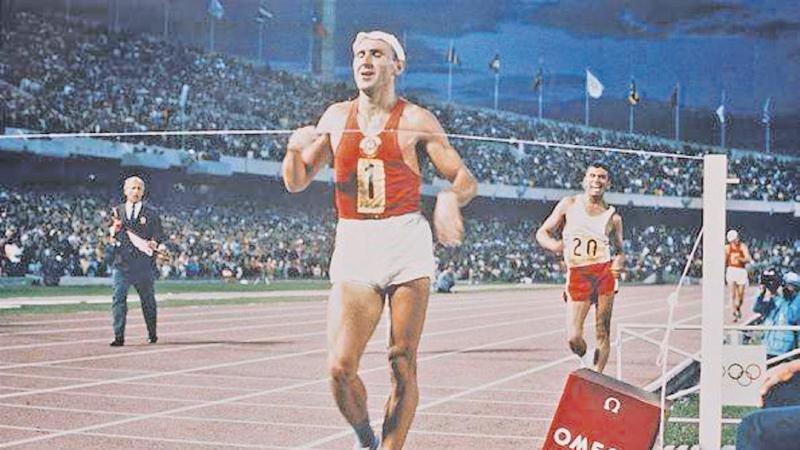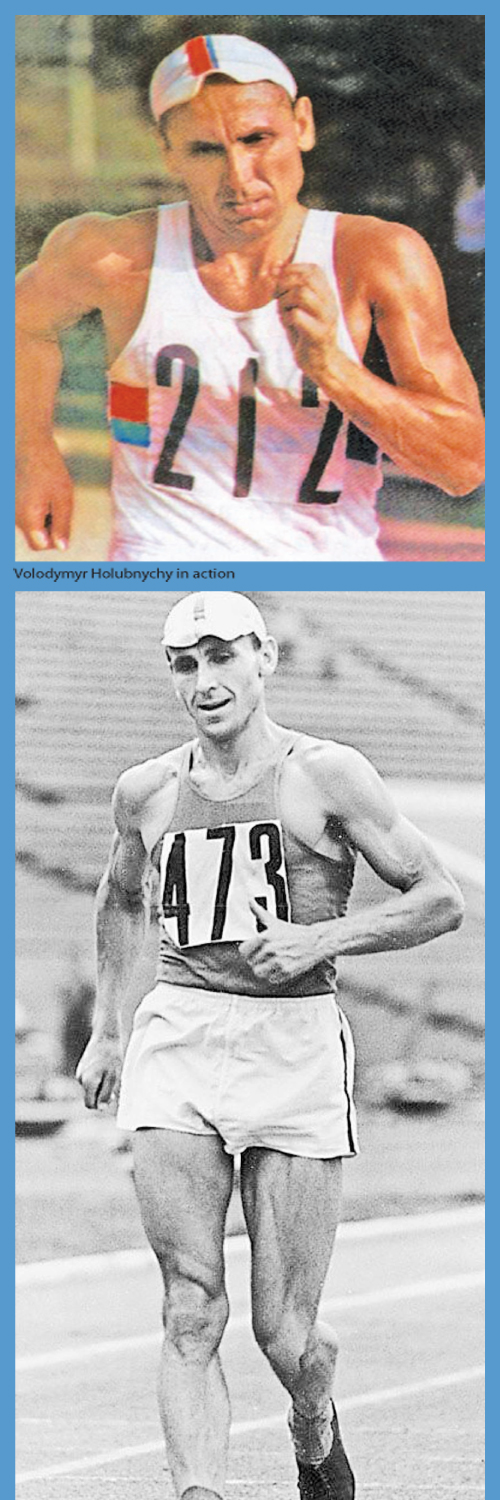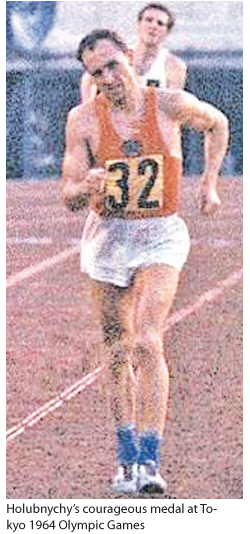
Volodymyr Holubnychy was a Soviet and Ukrainian race walker, who had a long and illustrious career.He dominated the 20-kilometre race walk in the 1960s and 1970s, winning four Olympic medals. He is regarded as one of the greatest treasures of all time and competed at five successive Olympic Games 1960 through 1976. At the Summer Olympic Games, the 20km race walk has been a regular men’s event since 1956. Volodymyr Holubnychy is the only athlete to have ever won two Olympic gold medals in the 20km walk, in the Summer Olympic Games history.
In the race walking, one foot must always be in contact with the ground. A violation of this rule is called “lifting.” In addition, rules state that an athlete’s advancing leg must remain straight from the point of contact with the ground until the athlete’s passes over it. Judges observe the race and caution competitors if it appears a competitor is breaking above rules and three violations leads to disqualification.
Legendary race walker Volodymyr Holubnychy bettered the 20km world record on 3 occasions, with two of those performances ratified as official records: 1:30:36 (September 23, 1955 at Kiev, Soviet Union) and 1:27:04 (July 15, 1959 at Moscow, Soviet Union). He medalled at four Olympic Games (2 golds in 1960 and 1968, 1 silver and 1 bronze), three European championships (gold, silver and bronze) and two Lugano Cups (2 silvers).
Birth and Growth
Volodymyr Stepanovych Holubnychiyalso spelt Vladimir Golubnichy was born on June 2, 1936 and raised in Sumy. His career as a walker started by accident when at 13, he was cajoled into taking place in a schools’ competition walk when the second school representative took sick. He won the event and the rest is history. At 17, he easily won the Ukrainian 10km walk championship, beating a number of highly credentialed walkers.
 Holubnychy initially pursued his interest in cross-country skiing and later took up race walking in 1953. He was convinced to take up race walking by former Soviet Union weightlifting champion Zosima Petrovich who was one of his lecturers at the Kyiv Physical Education Institute where he had joined in 1953 with the intention of becoming a ski instructor.
Holubnychy initially pursued his interest in cross-country skiing and later took up race walking in 1953. He was convinced to take up race walking by former Soviet Union weightlifting champion Zosima Petrovich who was one of his lecturers at the Kyiv Physical Education Institute where he had joined in 1953 with the intention of becoming a ski instructor.
He followed up with Ukrainian records at various distances and in 1955 at 19, he became the 20km world record holder, winning in Kiev clocking 1:30:36. His record did not last long as Josef Dolezal lowered it to 1:30:00 in 1956 and then Valentin Guk lowering it to 1:28:39 in 1957. Later, Leonid Spirin lowered it further to 1:27:29 in 1959.
The Soviets were expected to clean sweep the medals in the Melbourne 1956 Olympics but, surprisingly, Volodymyr Holubnychy was not in the team – he remained at home with a serious inflammation of the liver which threatened to end his walking career. He was believed to have afflicted with liver infection due to his malnourished childhood during World War II.
History reveals that the Soviets still took all three medals in the 20km walk with Spirin winning in 1:31.27.4, followed by Antanas Mikenas and Bruno Junk. It took a long time for the young Ukrainian to fully recover from his debilitating illness but the world knew he was truly back when, on July 15, 1959, in Moscow, Holubnychy regained his 20km world record with 1:27:04.
Rome 1960 Olympics
He was chosen a member of the Soviet team and reached the 1960 Rome Olympic Games as the clear favourite and he did not disappoint. He clinched gold medal in the men’s 20km walk event on his Olympic debut which literally took everyone by surprise, given his fifth-place finish in a trial race walk which was held prior to the Olympic final.
The men’s 20km walk event at the 1960 Olympic Games took place on September 2. The event was held in a final only format.
He entered the stadium well in front and started his final lap of the track, soaking in the applause and savouring the moment. What he did not realise was that a young unknown Australian by the name of Noel Freeman was making big inroads into his lead and was in sight of a huge upset.
Eventually Volodymyr Holubnychy looked around, saw Freeman, accelerated and went on to win by 9 seconds in a time of 1:34:16.4. It had been a sweltering Rome day and the slow times did not really reflect the quality of the performances.
By way of historical anecdote, Holubnychy was perhaps lucky to win the gold medal, finishing with 8 cautions and 2 official warnings. In comparison, the next 3 finishers all had clean slates.
The medalists of the men’s 20km race walk at Rome 1960 Olympic Games: Gold medal - Vladimir Holubnychy of the Soviet Union at 1:34:07.2; Silver medal - Noel Freeman of Australia at 1:34:16.4; Bronze medal - Stan Vickers of the Great Britain at 1:34:56.4.
International opportunities were few in those days, so Holubnychy’s next big race was not until 1962, when he won bronze in that year’s European Champs 20km in Belgrade, the time a slow 1:36:38 in hot conditions. On that occasion, he was bettered by Great Britain’s Ken Matthews and East Germany’s Hans-Georg Reimann.
Tokyo 1964 Olympics
Volodymyr Holubnychy went into the 1964 Olympics as the defending champion but all was not well. The 1964 season had been very demanding for the Soviet Union’s top athletes, with frequent competitions and a long period spent in peak competitive form before the Olympics relegating them to the role of outsiders at Tokyo.
This illustrates the point that even in the most highly skilled and regimented coaching regimes, mistakes can still be made. The men’s 20km walk was held on October 15, 1964, 35 athletes from 15 nations entered, with 30 starting and 26 finishing.
Holubnychy’s effort in the 1964 Summer Olympic Games says a lot about the measure of the man. During the competition, he suffered from headaches soon after the start and also reportedly fell on the road in the middle of the 20km distance final. Standing 178 cm and weighing 77 kgs, he picked himself up, started again and slowly moved up through the field and eventually finished third.
The medalists of the Men’s 20km Race Walk: Gold medal - Ken Matthews of Great Britain at 1:29:34.0;Silver medal - Dieter Lindner of East Germany at 1:31:13.2; Bronze medal - Vladimir Golubnichy of the Soviet Union at 1:31:59.4.
Yet, this bronze medal was particularly special to him as he said, it represented his victory over himself, his ability to reveal and use hitherto unknown resources of strength. His good form continued over the next few years.
He took silver in the 1966 European Championship 20km walk in Budapest (1:30:06) and took silver in the 1967 Lugano Cup Final in Bad Saarow (1:28:58).
Mexico City 1968 Olympics
At the Mexico City 1968 Summer Olympics, he became the Olympic champion once again winning his second Olympic gold. The Soviets left nothing to chance in their preparation for the 1968 Olympics, flying into Mexico City a full month before, on the recommendation of their sports medicine experts.
The men’s 20km walk was held on October 14, 1968, with 34 athletes from 20 nations vying for honours. With ample time to watch the competition, it soon became clear that American Ron Laird looked the toughest proposition so, come the day of the Olympic 20km event, Holubnychy chose to shadow the American and ignore the rest of the field.
This was a major miscalculation as they soon found themselves at the back of the field and fast losing ground on the leaders. Both walkers had to put on a burst of speed to catch the leaders. But this came at a cost and the American soon fell back while Holubnychy struggled in the group, trying to recover.
 His roommate and training partner Smaga knew what he had to do, taking the lead and controlling the race for the first 18km before helping Holubnychy break clear of the field. The two Soviet friends entered the stadium looking certainties for gold and silver.
His roommate and training partner Smaga knew what he had to do, taking the lead and controlling the race for the first 18km before helping Holubnychy break clear of the field. The two Soviet friends entered the stadium looking certainties for gold and silver.
Then the 60,000-plus spectators went wild as a third walker appeared – Mexican champion Jose Pedraza. Two hundred metres from the finish, Pedraza passed Smaga and set his sights on Holubnychy. Pedraza’s style seemed far from legal and he received three cautions.
But it would have taken a suicidal judge to disqualify the determined Pedraza while the stadium echoed with chants of “May-hee-co” and “Pay-drah-zah.” An international incident was avoided when Holubnychy drew away slightly in the homestretch to win by a mere three yards.
Vic Sharpe, the Australian representative on the Olympic 20km panel confided in later years that the Mexico City 1968 Olympics was one of his most memorable judging experiences but “I wasn’t going to put a red on Pedrasa – I wanted to get out of Mexico alive.”
The medalists of the Men’s 20km Race Walk: Gold medal – Volodymyr Holubnychy of the Soviet Union at 1-33:58.4; Silver medal – Jose Pedraza of Mexico at 1-34:00.0; Bronze medal – Nikolay Smaga of the Soviet Union at 1-34:03.4.
In July 1969, Volodymyr Holubnychy took the silver medal in the 20km walk in the USA vs USSR vs British Commonwealth Track and Field Meet in Los Angeles (1:32:11.0). Holubnychy was back in action in 1970, taking the silver in the Lugano Cup 20km Final in Eschborn (1:27:22).
Munich 1972 Olympics
At Munich 1972, in the 20km event, it was Volodymyr Holubnychy who stopped an East German clean sweep of the medals. The East German sports machine had been born and was now bearing the first fruits of its ruthlessly scientific sports development program. This program produced champions up until the fall of the Berlin Wall in 1990.
The silver medal, won at 36, seemed to nicely round off his sporting career, but he felt otherwise. “Right after the medal ceremony, I went up into the stands to our fans and coaches”, wrote Holubnychy in his diary, “and I was congratulated, my hand shook. And suddenly I heard someone say, I’m sure without any malice, ‘Congratulations, old boy, you’ve made a fine finish to your sporting career!”
The Men’s 20km walk event at Munich was held on August 31. There were no heats and it was held as a final only event.The medalists of the Men’s 20km Race Walk: Gold medal - Peter Frenkel of East Germany with 1:26:42.4; Silver medal - Volodymyr Holubnychy of the Soviet Union at 1:26:55.2; Bronze medal - Hans-Georg Reimann of East Germany at 1:27:16.6.
Holubnychy was far from finished and he astounded everyone when in 1974, in a typically blistering Rome sun, he won the European Championship 20km title. He followed this up with a win in the 1975 Soviet National 20km championship in Kiev, his time an astonishing 1:23:55.0 – at 39 years of age!
Montreal 1976 Olympics
Volodymyr Holubnychy’s final Olympic appearance in 1976 was disappointing – only 7th in 1:29:24.6. It was the first time in five Olympics that he had failed to reach the podium – but he was 40 years! The Men’s 20km walk at Montreal 1976 Olympics was held on July 23, 1976. A total number of 36 athletes completed the race, while two did not finish.
The medalists of the Men’s 20km Race Walk: Gold medal - Daniel Bautista of Mexico at 1:24:40.6; Silver medal - Hans-Georg Reimann of East Germany at 1:25:13.8; Bronze medal - Peter Frenkel of East Germany at 1:25:29.4.
His final major international was the 1977 Lugano Cup in Le Grand Quevilly, France, and he finished 14th with a time of 1:30:33. His international resume reads impressively. Apart from his outstanding performance at the Olympics, he was the 1974 European Champion in 20km winning in Rome at 1:29:30.
He was also hard to beat on the home front, in an era when the Soviets dominated race walking. He was the Soviet 20km champion on 6 occasions, in 1960, 1964–65, 1968, 1972, and 1974. Volodymyr Holubnychy was the greatest walker of his era and stands alongside Jared Tallent and Robert Korzenioski at the top of race walking’s Hall of Fame.
After his retirement, Holubnychy competed at international masters’ events during the 1990s after the dissolution of the Soviet Union.His accolades were many. On the Soviet front, he was awarded the Order of the Red Banner of Labour (1960), the Order of the Badge of Honour (1969) and the Medal for LabourValour (1972).
Internationally, he was one of the 24 inaugural Members of the IAAF Hall of Fame. If he was a national hero at the Soviet level, he was a living legend and a national treasure within his native Ukraine.
A Legend in Sumy
In 2009, New Zealand walker Mike Parker was lucky enough to meet with Volodymyr Golubnichiy in his home town of Sumy. Mike’s comments paint a poignant picture of Golubnichiy as a humble man, generous with his time and possessions. Parker said, “We received word that Golubnichy was more than happy to meet me. I have to say that I am still reeling from the shock of the hospitality we received in Sumy.”
To my shock,Holubnychy and a contingent of press and television cameras waiting for our arrival. To cut a long and eventful story short, what I thought would be a brief ten minutes with Vladimir turned out to be a fantastic full day in his company, and what a man he is. I don’t think I have ever meet somebody who has achieved so much and is so humble.
We were shown the new ‘Vladimir Holubnychy Indoor Stadium’ built in his honour and taken to the track where it all began for him as a 15-year. I happened to mention to Vladimir that I used to have a book on him until I lent it to someone and never got it back. A minute later, Vladimir disappeared, he had driven home to get this book for me with a personalized inscription.
Parker concluded, “Vladimir took us to his apartment where we could not but be mightily impressed by the simplicity of his style of life, a life that has remained the same since the day he took up athletics. Vladimir showed us his array of trophies and medals.
Then we witnessed one of their training camps. Most of this growth in sport can be put down to Vladimir, a legend in Sumy and Ukrainian sport.”
Volodymyr Holubnychy died in his native Sumy, where he was born and lived throughout his life, on August 16, 2021, two months after his 85th birthday.
(The author is an Associate Professor, International Scholar, winner of Presidential Awards and multiple National Accolades for Academic pursuits. He possesses a PhD, MPhil and double MSc. His email is [email protected])
